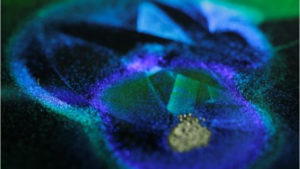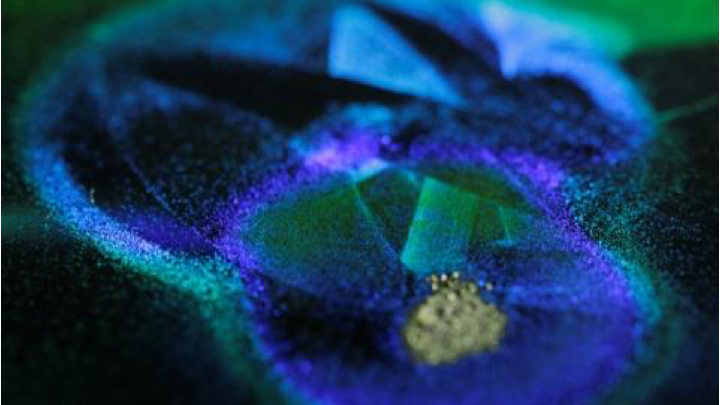Coloured by Flavo
Coloured by Flavo
Coordination/Researcher TUDelft/Avans:
Elvin Karana
Coordination WDKA:
Aldje van Meer
Charlotte Bik
Scientist:
Colin J. Ingham & Radi Hamidjaja
Researchers/Artist/Designer:
Ivan Henriques
Emma Van Der Leest
MA Student, Researcher TUDelft:
Ward Groutars
Partners:
TU Delft, Avans University of Applied Sciences, CARADT, Willem de Kooning Academy, Wageningen University & Research, Protospace, Hoekmine B.V , BlueCity Lab
Structural Color
Structural Color is by no means a new phenomenon. Back in the 17th century, English scientists Robert Hooke and Isaac Newton observed the first structural colour in nature. Structural colour is visible in a number of organisms including the peacock tail feather, in which nanostructures interact with incident light to reflect intense hues, the Morpho butterfly and the shield of a beetle amongst others. Microscopically structured surfaces interfere with light and creating iridescent colours. In this research, we collaborate with Flavoacteria grown on low-value industrial waste, to create structural colour.
How does the Flavobacteria produces its structural color, and what is it exactly?
The challenge is to explore possibilities of the creation of objects and artifacts that are alive and can grow in such a way that the color of the artifacts colors can change through the structure of the objects in relation to the light reflecting the iridescence color.
How can we keep the Flavo alive? Within this question it opens for multiple ones; do we need to keep it alive? why and for what purpose? Can we use the properties of the structure to give color to our buildings, fashion and daily objects, without using polluting dyes? Can we grow it in symbiosis with other natural occurring organisms in our city?
The initial experiments occurred in collaboration with scientists Raditijo Hamidjaja and Colin Ingham from Hoekmine BV and TU Delft researchers Elvin Karana and MA alumni Ward Grouters. During this exploration it has shown that the geometry determines in certain angles, the light reflects from surfaces and interferes constructively. Other angles show us that the light interferes destructively; different colours therefore appear at different angles. The iridescence only happens when the bacteria is alive or after a few days before death.
Picture extracted from the scientific paper “Genetic Manipulation of Structural Color in Bacterial Colonies” where they show a study of the genetic manipulation of the structural coloration of Flavobacterium IIR WT and mutants / Diagram explaining how the light occurs being scattered by the structure of the bacteria colony.
Except from the documentary Life That Glows, 2016. It is a British nature documentary programme made for BBC Television, first shown in the UK on BBC Two on 9 May 2016. The programme is presented and narrated by Sir David Attenborough. Life That Glows films the biology and ecology of bioluminescent organisms, that is, capable of creating light.
Research
Ivan and Emma harvested wild type Flavo bacteria from the Maas River in Rotterdam and De Esch, a city park. Flavobacteria are found in soil and fresh water in a variety of environments. The samples were stored in test tubes and jars. Immediately after the harvest they diluted drops of the water into a nutrient medium in the lab. They used cell spreaders to gently spread all the organisms in the petri dish. The water contains hundreds of other organisms such as bacteria and micro algae. In order to keep them alive, salt and a composition of nutrients are added to activate the Flavo bacteria. The process of isolating the Flavo could take days in order for them to light up between the other organisms. Once isolated, the colony can grown on its own.
Dissemination of Knowledge
workshop TUDelft
In September 2019, Ivan and Emma gave a series of workshops for TUDelft bachelor students from diverse engineering background. In this workshop, basics of laboratory protocols and usage were given, apart from an introduction of bioart and biodesign led by the artist/designer/reserchers Henriques and van der Leest. The aim for this workshop is to expand the students’ knowledge of emerging materials (smart and living materials) and their material pallets for prototyping.
The students were exploring possibilities of variables set by the workshop leaders. They divided themselves in groups and each one decided to go in depth in each of techniques with the focus in the change of time. They were observing the passage of time in of the bacteria from their transfer until their growth with the structures that they created.
In the first pictures, students used a 3D printer to create a surface where the flavo bacteria could adapt easily and create geometries to compose an artifact.
In a second moment, the same group created spheres with an edged rings to test the growth in such a surface.
The second group custom made petri dishes to fixate the bacteria with variable of resins to test their adaptation in flexible and hard materials, to keep the color over a long period.
The second test, is observing their growth. What is the influence of the gravity on the growth of the Flavo bacteria?
Below, the picture on the left, the flavo bacteria growing from top to down, on the right, growing from bottom to top.
The third experiment the elaboration of a candle that represents the ‘time’ and the flavo bacteria growing on its surface from top to down.
The third group within the research of time, created a zootrope, where each ‘slide’ was a petri-dish, inoculated with the flavo bacteria in different days.
The Zootroop made by TU students Pia van der Theems, Tomas de Vries and Marijn Soeterbroek
Workshop WDKA at BlueCity
In January 2020 Ivan and Emma gave an elective at Willem de Kooning students called ‘The Microbial Map of Rotterdam’. Students from different studies got a general introduction about biodesign and growing bacteria and fungi in the lab. The goal was to create a ‘living’ map that shows the city grid of Rotterdam including its soil life.
This installation presents 16 square petri dishes containing Flavobacteria and other microorganisms that were harvested from respective locations in Rotterdam. The Microbial Map shows the invisible yet important microbial life beneath our feet. It shows the collaboration between different species. They interact by showing different structures and colours produced by fungal mycelium to yeast and Lichen, a symbiosis between a fungi and algae or cyanobacteria and Flavobacteria that are present in the Maas river, ponds and canals in the city. All together they represent and grow the city boundaries of Rotterdam. The variety shows the beauty of different structures, colours, patterns that are as diverse as our city. Making the invisible visible forms your perception, experience and appreciation for the city and its nature.
Below two video’s of the Microbial Map of Rotterdam, here you can view all the photo’s of the process.
The Microbial Map of Rotterdam from Hilde Berkers on Vimeo.
Coloured by Flavo from Kamelia Markovska on Vimeo.



















